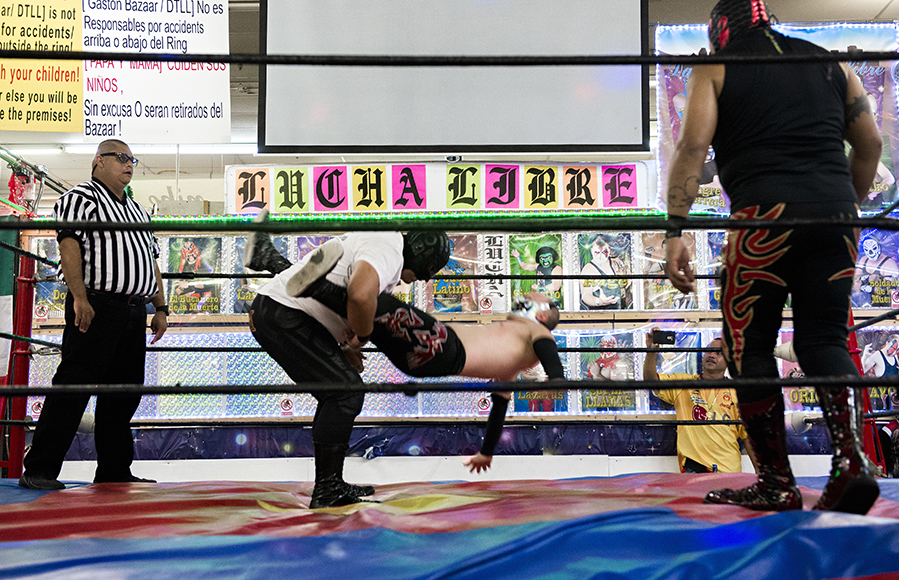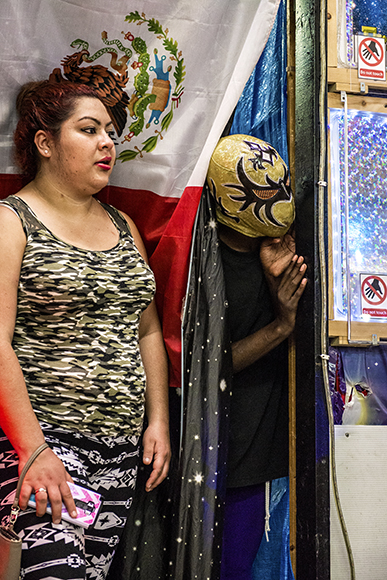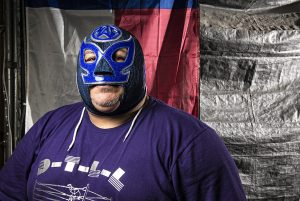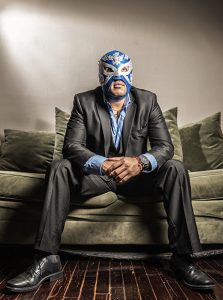
Luchadores at Gaston Bazaar (Photo by Danny Fulgencio)
Return to ‘Living on the edge’ home page
Sangre Guerrera flaps open a makeshift curtain, and enters under the fluorescent lights of Gaston Bazaar in far East Dallas.

Luchadores at Gaston Bazaar (Photo by Danny Fulgencio)
He climbs into the wrestling ring and struts around a few paces, pointing and shouting. Then he drops down and puts his masked face close to audience members sitting in metal folding chairs, everyone pointing and talking smack in Spanish.
Outside the ring, Guerrera is a quiet 52-year-old with a family and a job, but here at Dallas Texas Lucha Libre, he is a foil, the bad guy in a green-and-white luchador mask.
Since a larger, more popular bazaar opened in an old K-Mart just east of Interstate 30 a few years ago, wrestling matches have become the main attraction at Gaston Bazaar. The man behind the luchadores is Mac Reyes of Oak Cliff.
Reyes, who wrestled from 1989-2012, was a second-generation lucha. His father, also Mac Reyes, was from near Monterrey, Nuevo Leon, and was a popular and well-known wrestler in his day.
The younger Reyes is a 1986 Adamson High School graduate and debuted as a wrestler at the old Sears building on Jefferson when he was about 21. They also held wrestling matches at Casa Guanajuato and Rocket Skate Palace in the ’80s and ’90s.
Reyes started the Gaston Bazaar showcase four years ago as a way to boost the sport in Dallas. The event, every Saturday and Sunday from about 4-6:30 p.m., is donation based. Spectators can donate $3 for a chair, and the hat is passed between matches.

Sergio Reyes (Photo by Danny Fulgencio)
These bouts, although heavy on acting and choreographed moves, can get very serious. When foil Chaco destroys fan favorites Havoc and Dosis in a tag-team match one Sunday afternoon, the fans heckle and boo. Chaco revels in the confrontation; he taunts the audience and then pitches a water bottle, splashing several people in the front row. A guy wearing church clothes and expensive looking shoes shouts expletives in Spanish: “My phone is wet, you idiot!”
The fans throw water and boo heartily until Chaco finally exits to the makeshift backstage.

Wrestler Aski Palomino (Photo by Danny Fulgencio)
“We’re like a cheap psychologist,” says Aski, a luchador from Oak Cliff who declines to give his real name because he is masked, and the lucha code requires anonymity.
Wrestling matches offer fans a hero to cheer for and a villain to despise. It gives spectators a few hours to clear their heads and focus only on something fun, he says.
Aski, 35, started wrestling in 2004. He played soccer and football at North Dallas High School, but nothing measures up to this, he says.
The training is intense, and the sport requires physical and mental strength, not to mention acting skills. There are bumps and bruises every time, and wrestling careers sometimes end in back injuries, but blood and broken bones are very rare, Aski says.
Before entering the ring, there is an adrenaline rush, he says, speaking through the mask.
“We know we’re going into a battle, and we don’t know what the outcome will be,” he says. “It’s something that you look forward to, and it becomes part of you.”

Luchadores at Gaston Bazaar (Photo by Danny Fulgencio)




